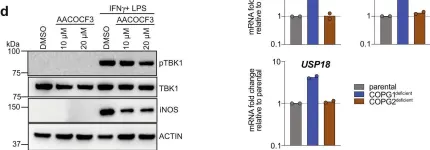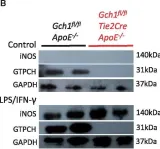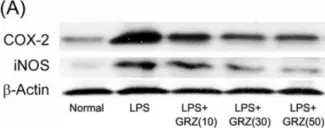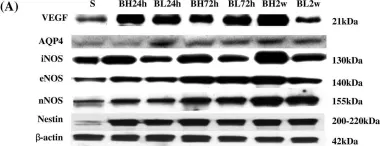Korean black ginseng, a specially processed ginseng through repeat steaming and drying, has various pharmacological effects. However, its role i n cognitive impairment remains unclear.
This study examined whether Korean black ginseng extract (BGE; 50 and 100 mg/kg, orally, 18 weeks) may mitigate cognitive impairment in a 5xFAD mouse model of Alzheimer's disease (AD).
BGE significantly improved cognitive performance in 5xFAD mice, associated with reduced Aβ accumulation in the frontal cortex and hippocampus. BGE suppressed microglial and astrocytic activation, alongside the downregulation of pro-inflammatory cytokines (interleukin-6 and tumor necrosis factor-α) and enzymes (cyclooxygenase-2 and inducible nitric oxide synthase). These changes coincided with the inhibition of key inflammatory signaling pathways, such as p38 mitogen-activated protein kinase (MAPK), nuclear factor kappa B (NF-κB)/p65, signal transducer and activator of transcription (STAT) 3, and NOD-like receptor protein 3 (NLRP3) inflammasome. Furthermore, BGE reduced the generation of reactive oxygen species and enhanced the nuclear-E2-related factor 2 (Nrf2)-heme oxygenase 1 (HO-1) signaling pathway in the brains linked to the downregulation of toll-like receptors (TLR)-2 and TLR-4 in the brain.
Taken together, BGE could improve AD-related cognitive decline and neurodegeneration by simultaneously regulating anti-inflammatory pathways (p38 MAPK/NF-κB/STAT3 and NLRP3 inflammasome) and an antioxidant pathway (Nrf2/HO-1) via modulation of TLR2/4.
© 2025 The Korean Society of Ginseng. Publishing services by Elsevier B.V.
Product Citations: 81
In Journal of Ginseng Research on 1 May 2025 by Ha, Y., Jo, H. S., et al.
-
Neuroscience
In Cellular and Molecular Life Sciences : CMLS on 26 March 2025 by Montilla, A., Zabala, A., et al.
Interferon regulatory factor 5 (IRF5) is a transcription factor that plays a role in orchestrating innate immune responses, particularly in response to viral infections. Notably, IRF5 has been identified as a microglia risk gene linked to multiple sclerosis (MS), but its specific role in MS pathogenesis remains unclear. Through the use of Irf5-/- mice, our study uncovers a non-canonical function of IRF5 in MS recovery. Irf5-/- mice exhibited increased damage in an experimental autoimmune encephalomyelitis (EAE) model and demonstrated impaired oligodendrocyte recruitment into the lesion core following lysolecithin-induced demyelination. Transcriptomic and lipidomic analyses revealed that IRF5 has a role in microglia-mediated myelin phagocytosis, lipid metabolism, and cholesterol homeostasis. Indeed, Irf5-/- microglia phagocytose myelin, but myelin debris is not adequately degraded, leading to an accumulation of lipid droplets, cholesterol esters, and cholesterol crystals within demyelinating lesions. This abnormal buildup can hinder remyelination processes. Importantly, treatments that promote cholesterol transport were found to reduce lipid droplet accumulation and mitigate the exacerbated damage in Irf5-/- mice with EAE. Altogether, our study identified the antiviral transcription factor IRF5 as a key transcriptional regulator of lipid degradation and cholesterol homeostasis and suggest that loss of IRF5 function leads to pathogenic lipid accumulation in microglia, thereby obstructing remyelination. These data and the fact that Irf5 polymorphisms are significantly associated with MS, highlight IRF5 as a potential therapeutic target to promote regenerative responses.
© 2025. The Author(s).
-
Biochemistry and Molecular biology
-
Cell Biology
-
Neuroscience
Senescent-like microglia limit remyelination through the senescence associated secretory phenotype.
In Nature Communications on 7 March 2025 by Gross, P. S., Durán-Laforet, V., et al.
The capacity to regenerate myelin in the central nervous system diminishes with age. This decline is particularly evident in multiple sclerosis (MS), a chronic demyelinating disease. Whether cellular senescence, a hallmark of aging, contributes to remyelination impairment remains unknown. Here, we show that senescent cells accumulate within demyelinated lesions after injury, and treatments with senolytics enhances remyelination in young and middle-aged mice but not aged mice. In young mice, we observe the upregulation of senescence-associated transcripts, primarily in microglia and macrophages, after demyelination, followed by a reduction during remyelination. However, in aged mice, senescence-associated factors persist within lesions, correlating with inefficient remyelination. Proteomic analysis of the senescence-associated secretory phenotype (SASP) reveals elevated levels of CCL11/Eotaxin-1 in lesions of aged mice, which is found to inhibit oligodendrocyte maturation. These results suggest therapeutic targeting of SASP components, such as CCL11, may improve remyelination in aging and MS.
© 2025. The Author(s).
-
Neuroscience
In Frontiers in Cellular Neuroscience on 18 November 2024 by Mata, P., Calovi, S., et al.
Ischemic stroke consists of rapid neural death as a consequence of brain vessel obstruction, followed by damage to the neighboring tissue known as ischemic penumbra. The cerebral tissue in the core of the lesions becomes irreversibly damaged, however, the ischemic penumbra is potentially recoverable during the initial phases after the stroke. Therefore, there is real need for emerging therapeutic strategies to reduce ischemic damage and its spread to the penumbral region. For this reason, we tested the effect of Extreme Low Frequency Electromagnetic Stimulation (ELF-EMS) on in vitro primary neuronal and microglial cultures under oxygen-glucose deprivation (OGD) conditions. ELF-EMS under basal non-OGD conditions did not induce any effect in cell survival. However, ELF-EMS significantly reduced neuronal cell death in OGD conditions and reduced ischemic induced Ca2+ overload. Likewise, ELF-EMS modulated microglia activation and OGD-induced microglia cell death. Hence, this study suggests potential benefits in the application of ELF-EMS to limit ischemic irreversible damages under in vitro stroke conditions, encouraging in vivo preclinical validations of ELF-EMS as a potential therapeutic strategy for ischemic stroke.
Copyright © 2024 Mata, Calovi, Benli, Iglesias, Hernández, Martín, Pérez-Samartín, Ramos-Murguialday, Domercq and Ortego-Isasa.
-
Neuroscience
In Nature Communications on 24 October 2024 by Nath, S., Martínez Santamaría, J. C., et al.
After a stroke, the neurogenic response from the subventricular zone (SVZ) to repair the brain is limited. Microglia, as an integral part of the distinctive SVZ microenvironment, control neural stem / precursor cell (NSPC) behavior. Here, we show that discrete stroke-associated SVZ microglial clusters negatively impact the innate neurogenic response, and we propose a repository of relevant microglia-NSPC ligand-receptor pairs. After photothrombosis, a mouse model of ischemic stroke, the altered SVZ niche environment leads to immediate activation of microglia in the niche and an abnormal neurogenic response, with cell-cycle arrest of neural stem cells and neuroblast cell death. Pharmacological restoration of the niche environment increases the SVZ-derived neurogenic repair and microglial depletion increases the formation and survival of newborn neuroblasts in the SVZ. Therefore, we propose that altered cross-communication between microglial subclusters and NSPCs regulates the extent of the innate neurogenic repair response in the SVZ after stroke.
© 2024. The Author(s).
-
IHC
-
Mus musculus (House mouse)
-
Cardiovascular biology
-
Neuroscience
-
Stem Cells and Developmental Biology
In Nat Commun on 28 April 2022 by Steiner, A., Hrovat-Schaale, K., et al.
Fig.6.D

-
WB
-
Homo sapiens (Human)
Collected and cropped from Nat Commun by CiteAb, provided under a CC-BY license
Image 1 of 6
In Cardiovasc Res on 1 August 2018 by Douglas, G., Hale, A. B., et al.
Fig.5.B

-
WB
-
Mus musculus (House mouse)
Collected and cropped from Cardiovasc Res by CiteAb, provided under a CC-BY license
Image 1 of 6
In PLoS One on 4 April 2017 by Paterniti, I., Campolo, M., et al.
Fig.5.A

-
WB
-
Collected and cropped from PLoS One by CiteAb, provided under a CC-BY license
Image 1 of 6
In J Neuroinflammation on 10 October 2014 by Zou, Y. Y., Yuan, Y., et al.
Fig.4.A

-
WB
-
Collected and cropped from J Neuroinflammation by CiteAb, provided under a CC-BY license
Image 1 of 6
In Molecules on 17 December 2013 by Song, J. H., Lee, J. W., et al.
Fig.3.A

-
WB
-
Mus musculus (House mouse)
Collected and cropped from Molecules by CiteAb, provided under a CC-BY license
Image 1 of 6
In J Neuroinflammation on 2 July 2013 by Zou, Y. Y., Kan, E. M., et al.
Fig.2.A

-
WB
-
Collected and cropped from J Neuroinflammation by CiteAb, provided under a CC-BY license
Image 1 of 6





